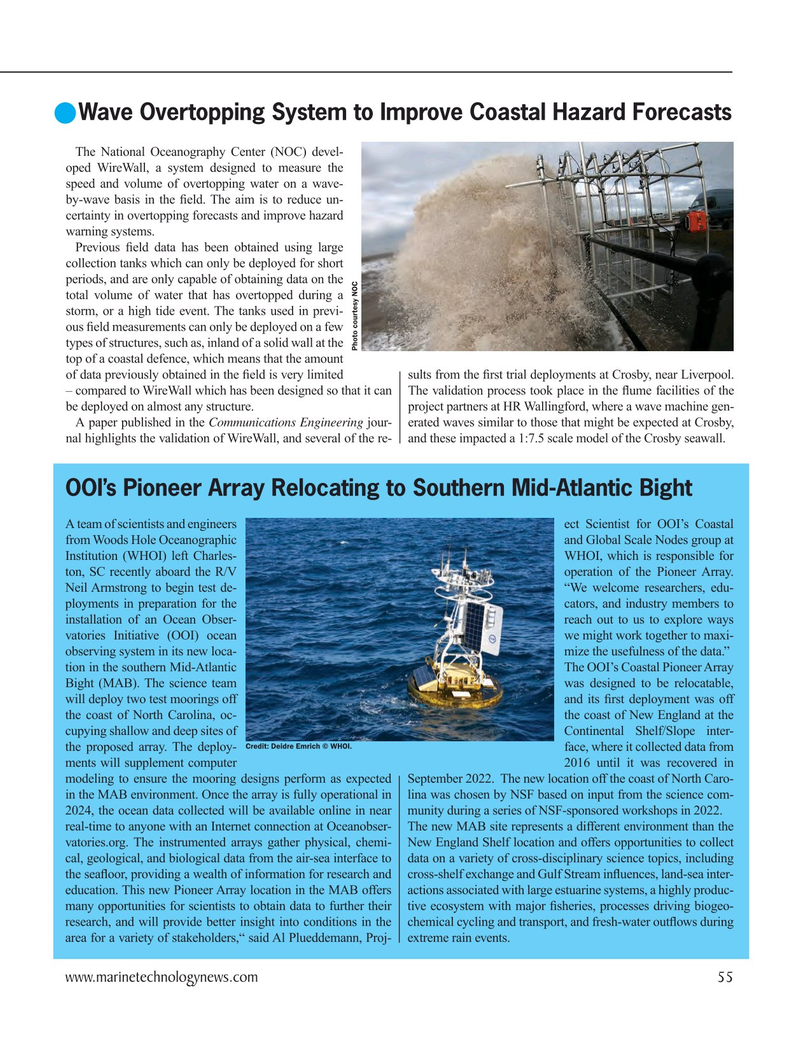
Page 55: of Marine Technology Magazine (March 2023)
Read this page in Pdf, Flash or Html5 edition of March 2023 Marine Technology Magazine
Wave Overtopping System to Improve Coastal Hazard Forecasts
The National Oceanography Center (NOC) devel- oped WireWall, a system designed to measure the speed and volume of overtopping water on a wave- by-wave basis in the ? eld. The aim is to reduce un- certainty in overtopping forecasts and improve hazard warning systems.
Previous ? eld data has been obtained using large collection tanks which can only be deployed for short periods, and are only capable of obtaining data on the total volume of water that has overtopped during a storm, or a high tide event. The tanks used in previ- ous ? eld measurements can only be deployed on a few types of structures, such as, inland of a solid wall at the
Photo courtesy NOC top of a coastal defence, which means that the amount of data previously obtained in the ? eld is very limited sults from the ? rst trial deployments at Crosby, near Liverpool. – compared to WireWall which has been designed so that it can The validation process took place in the ? ume facilities of the be deployed on almost any structure. project partners at HR Wallingford, where a wave machine gen-
A paper published in the Communications Engineering jour- erated waves similar to those that might be expected at Crosby, nal highlights the validation of WireWall, and several of the re- and these impacted a 1:7.5 scale model of the Crosby seawall.
OOI’s Pioneer Array Relocating to Southern Mid-Atlantic Bight
A team of scientists and engineers ect Scientist for OOI’s Coastal from Woods Hole Oceanographic and Global Scale Nodes group at
Institution (WHOI) left Charles- WHOI, which is responsible for ton, SC recently aboard the R/V operation of the Pioneer Array.
Neil Armstrong to begin test de- “We welcome researchers, edu- ployments in preparation for the cators, and industry members to installation of an Ocean Obser- reach out to us to explore ways vatories Initiative (OOI) ocean we might work together to maxi- observing system in its new loca- mize the usefulness of the data.” tion in the southern Mid-Atlantic The OOI’s Coastal Pioneer Array
Bight (MAB). The science team was designed to be relocatable, will deploy two test moorings off and its ? rst deployment was off the coast of North Carolina, oc- the coast of New England at the cupying shallow and deep sites of Continental Shelf/Slope inter-
Credit: Deidre Emrich © WHOI.
the proposed array. The deploy- face, where it collected data from ments will supplement computer 2016 until it was recovered in modeling to ensure the mooring designs perform as expected September 2022. The new location off the coast of North Caro- in the MAB environment. Once the array is fully operational in lina was chosen by NSF based on input from the science com- 2024, the ocean data collected will be available online in near munity during a series of NSF-sponsored workshops in 2022. real-time to anyone with an Internet connection at Oceanobser- The new MAB site represents a different environment than the vatories.org. The instrumented arrays gather physical, chemi- New England Shelf location and offers opportunities to collect cal, geological, and biological data from the air-sea interface to data on a variety of cross-disciplinary science topics, including the sea? oor, providing a wealth of information for research and cross-shelf exchange and Gulf Stream in? uences, land-sea inter- education. This new Pioneer Array location in the MAB offers actions associated with large estuarine systems, a highly produc- many opportunities for scientists to obtain data to further their tive ecosystem with major ? sheries, processes driving biogeo- research, and will provide better insight into conditions in the chemical cycling and transport, and fresh-water out? ows during area for a variety of stakeholders,“ said Al Plueddemann, Proj- extreme rain events. www.marinetechnologynews.com 55
MTR #3 (50-63).indd 55 3/20/2023 12:59:15 PM

 54
54

 56
56
